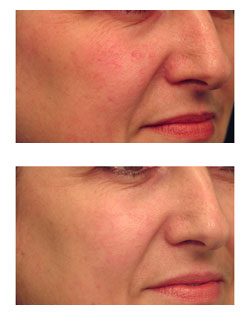Laser Treatments for red and raised scars, leg veins, rosacea, and persistent facial flushing

. What types of lesions can be treated with laser?
The V-Beam laser is the most advanced type of pulsed dye laser. It is the most effective instrument for removing spider veins (small dilated vessels usually on the face), and cherry angiomas (small red spots on the face and body). These lesions often clear with only one or two treatments. The Pulsed Dye Laser can also help fade, over the course of multiple treatments, red or raised scars, “port wine stain” birthmarks, and red discoloration of the face from rosacea. Although leg veins respond better to sclerotherapy, laser can be used to treat vessels that are too small for sclerotherapy. Unfortunately, all of these conditions, with the possible exception of some facial birthmarks, are considered cosmetic and are not covered by insurance.
2. How does the laser work?
The V-Beam Laser emits a burst of light tuned precisely to target the red pigment in blood and blood vessels without harming other parts of the skin. Therefore, this laser can remove dilated blood vessels while leaving the surrounding skin intact. A brief pulse of a cold spray precedes the pulse of light, further protecting the skin from injury.
3. Does treatment hurt?
Each pulse of light feels like the snapping of a small rubber band, while the cool spray of the laser minimizes this brief discomfort. A topical numbing cream called LMX may further decrease discomfort. A 30 gram tube may be ordered from your pharmacy without a prescription. Apply a generous amount of LMX 1 hour before your appointment and rub into the skin. Repeat this application 15 minutes before the appointment.
4. What does the skin look like after treatment?
The intensity of the treatment can be adjusted to each patient's needs. Each pulse of light treats approximately the size of a pencil eraser. If done more conservatively, you may experience only redness and slight swelling. If the treatment is more aggressive, spots can sometimes turn a purple bruised color that can last for a week. You may want to schedule the treatment at a time when no major work or social events are planned so that we can most effectively treat the problem area.
5. What are the risks?
Complications of treatment with the pulsed dye laser are uncommon. Dark discoloration (hyperpigmentation) of the treated area is unlikely to occur and would fade over months; however, it is important to avoid sun exposure after treatment to minimize this risk. Light discoloration (hypopigmentation) and scarring are extremely rare, unless you have recently taken a medication called Accutane for acne. Swelling is common when large areas of the cheeks are treated, but generally resolves in a few days. Laser light cannot penetrate deeper than the skin and will not harm internal organs, but goggles must be worn to protect the eyes. Some lesions may not be completely cleared by the treatment, requiring more treatments at additional cost.
The V-Beam laser is the most advanced type of pulsed dye laser. It is the most effective instrument for removing spider veins (small dilated vessels usually on the face), and cherry angiomas (small red spots on the face and body). These lesions often clear with only one or two treatments. The Pulsed Dye Laser can also help fade, over the course of multiple treatments, red or raised scars, “port wine stain” birthmarks, and red discoloration of the face from rosacea. Although leg veins respond better to sclerotherapy, laser can be used to treat vessels that are too small for sclerotherapy. Unfortunately, all of these conditions, with the possible exception of some facial birthmarks, are considered cosmetic and are not covered by insurance.
2. How does the laser work?
The V-Beam Laser emits a burst of light tuned precisely to target the red pigment in blood and blood vessels without harming other parts of the skin. Therefore, this laser can remove dilated blood vessels while leaving the surrounding skin intact. A brief pulse of a cold spray precedes the pulse of light, further protecting the skin from injury.
3. Does treatment hurt?
Each pulse of light feels like the snapping of a small rubber band, while the cool spray of the laser minimizes this brief discomfort. A topical numbing cream called LMX may further decrease discomfort. A 30 gram tube may be ordered from your pharmacy without a prescription. Apply a generous amount of LMX 1 hour before your appointment and rub into the skin. Repeat this application 15 minutes before the appointment.
4. What does the skin look like after treatment?
The intensity of the treatment can be adjusted to each patient's needs. Each pulse of light treats approximately the size of a pencil eraser. If done more conservatively, you may experience only redness and slight swelling. If the treatment is more aggressive, spots can sometimes turn a purple bruised color that can last for a week. You may want to schedule the treatment at a time when no major work or social events are planned so that we can most effectively treat the problem area.
5. What are the risks?
Complications of treatment with the pulsed dye laser are uncommon. Dark discoloration (hyperpigmentation) of the treated area is unlikely to occur and would fade over months; however, it is important to avoid sun exposure after treatment to minimize this risk. Light discoloration (hypopigmentation) and scarring are extremely rare, unless you have recently taken a medication called Accutane for acne. Swelling is common when large areas of the cheeks are treated, but generally resolves in a few days. Laser light cannot penetrate deeper than the skin and will not harm internal organs, but goggles must be worn to protect the eyes. Some lesions may not be completely cleared by the treatment, requiring more treatments at additional cost.